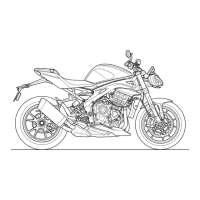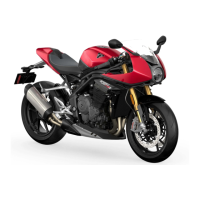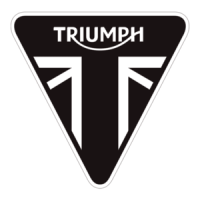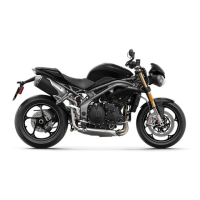Do you have a question about the Triumph Speed Triple 1200 RS and is the answer not in the manual?
Provides warnings about motorcycle design limitations and safe usage.
Advises on essential protective riding gear, including helmets and clothing.
Covers essential safety aspects of riding, including fatigue, drugs, and licensing.
Details the layout and function of all indicators and controls on the instrument panel.
Explains the meaning of various warning lights and their implications.
Describes the MIL light, its function, and actions to take when illuminated.
Explains the low oil pressure warning light and immediate actions required.
Details the ABS warning light behavior and potential system issues.
Advises on riding with illuminated ABS warning light and potential actions.
Explains the function and indicators of the Traction Control system.
Advises on stopping the motorcycle when the tyre pressure warning light illuminates.
Lists and explains various warning and information messages displayed on the motorcycle.
Introduces riding modes and their function in adjusting motorcycle settings.
Provides further details on selecting riding modes, including warnings and notes.
Explains how to access and select riding modes from the Settings menu.
Provides a table detailing ABS, MAP, and TC options for each riding mode.
Details ABS settings and descriptions for different riding modes.
Explains how to enable or disable the Traction Control system.
Provides warnings and guidelines for using the cruise control system.
Details the conditions and steps required to activate cruise control.
Explains the function of traction control and its limitations.
Explains how to set traction control and the TC disabled warning light.
Explains the running-in process for new vehicles to ensure optimal performance.
Lists essential daily checks to ensure a safe and reliable ride.
Continues instructions for starting the engine, including lockout switches and immobiliser notes.
Explains the procedure for moving the motorcycle off from a standstill.
Provides warnings and instructions for changing gears safely.
Details the steps for changing gears, including clutch use.
Introduces the integrated braking system and ABS, and how brakes are applied.
Provides crucial warnings and steps for effective braking.
Offers detailed warnings about braking, cornering, and conditions affecting performance.
Explains the ABS function, its limitations, and the ABS warning light.
Provides warnings about ABS operation, tyre use, and cornering.
Continues explanation of optimized cornering ABS, including its limitations.
Details safe parking procedures, including surface, incline, and ignition switch position.
Discusses operating the motorcycle at high speeds and necessary precautions.
Warns against riding above 80 mph with accessories or payload due to stability changes.
Provides guidelines for distributing and securing loads, and respecting weight limits.
Discusses how passengers affect handling and braking, and rider instruction.
Warns against incorrect maintenance and advises using authorised dealers.
Explains the three ways scheduled maintenance can be carried out.
Continues the table of maintenance operations and intervals.
Warns about operation with insufficient oil and the importance of correct oil level.
Explains how to accurately inspect the engine oil level using the sight glass.
Covers refitting covers, the TSA sensor, and starting the engine after oil change.
Explains how to inspect the coolant level in the expansion tank.
Details how to adjust the coolant level and refit the expansion tank cover.
Warns about loose or worn drive chains and the importance of maintenance.
Explains how to inspect the drive chain's vertical movement and the acceptable range.
Warns about insecure pinch bolts and mentions checking brake effectiveness.
Explains how to inspect drive chain and sprocket wear, and when to replace them.
Explains breaking in new brake pads and discs, and replacing pads as a set.
Details checking brake pad wear and warnings about non-proprietary pads.
Warns about brake fluid absorbing moisture and the importance of replacement.
Details filling the reservoir and fitting the reservoir cap assembly.
Explains how to inspect and adjust the rear brake fluid level.
Explains how to inspect wheel bearings and when to consult a dealer.
Details how to inspect the front forks for roughness, stiffness, or leaks.
Warns about incorrect tyre inflation causing instability and accidents.
Explains that tyre wear increases puncture susceptibility and recommends replacement.
Warns about hazards of worn tyres and specifies minimum tread depths.
Emphasizes using approved tyres and inner tubes, and proper fitting.
Warns against using tube-type tyres on tubeless rims and inner tubes in tubeless tyres.
Advises inspecting tyres for damage and consulting dealers for inspection.
Stresses the importance of accurate wheel balance and not altering weights.
Introduces the LiFePO4 lithium-ion battery and its hazardous materials.
Warns about overcharging/discharging and using specific chargers for lithium batteries.
Provides maximum charge rates and instructions for charging the lithium-ion battery.
Lists hazardous properties of lithium-ion batteries and warnings against misuse.
Repeats refuelling safety instructions and procedures after refuelling.
Explains how to vertically adjust the headlights and checks to perform.
Lists available information on dimensions, weights, and performance figures.
Provides detailed specifications for the motorcycle's engine.
Details the lubrication system and engine oil capacities.
Lists coolant type, ratio, capacity, and thermostat opening temperature.
Provides specifications for the fuel system, including type, injectors, and fuel pressure.
Specifies fuel type and tank capacity.
Lists transmission type, clutch type, final drive, and gear ratios.
Specifies tyre sizes and cold inflation pressures for front and rear.
Lists key tightening torque specifications for various components.
Specifies fluids and lubricants for bearings, pivots, brake fluid, coolant, and engine oil.
| Engine Type | Liquid-cooled, 12 valve, DOHC, inline 3-cylinder |
|---|---|
| Engine Capacity | 1160 cc |
| Bore x Stroke | 90.0 x 60.8 mm |
| Compression Ratio | 13.2:1 |
| Max Torque | 125 Nm @ 9, 000 rpm |
| Fuel System | Multipoint sequential electronic fuel injection with electronic throttle control |
| Final Drive | X-ring chain |
| Transmission | 6-speed |
| Front Wheel | Cast aluminium alloy 17 x 3.5 in |
| Rear Wheel | Cast aluminium alloy 17 x 6.0 in |
| Front Tyre | 120/70 ZR 17 |
| Rear Tyre | 190/55 ZR 17 |
| Length | 2090 mm |
| Seat Height | 830 mm |
| Wheelbase | 1445 mm |
| Rake | 23.9° |
| Dry Weight | 198 kg |
| Fuel Tank Capacity | 15.5 litres |
| Max Power | 180 PS (177.5 bhp) (132.4 kW) @ 10, 750 rpm |
| Exhaust | Stainless steel 3 into 1 header system, side mounted stainless steel silencer |
| Clutch | Wet, multi-plate |
| Frame | Aluminium twin spar |
| Swingarm | Single-sided, cast aluminium |
| Front Suspension | Ohlins 43 mm USD forks, fully adjustable |
| Rear Suspension | Ohlins RSU, fully adjustable |
| Front Brakes | Twin 320 mm discs, Brembo Stylema 4-piston radial monobloc calipers, OC-ABS |
| Rear Brakes | Single 220 mm disc, Brembo 2-piston caliper, OC-ABS |
| Instrument Display | 5" TFT instrument pack |
| Width (Handlebars) | 792 mm |
| Height Without Mirrors | 1089 mm |
| Trail | 104.7 mm |












